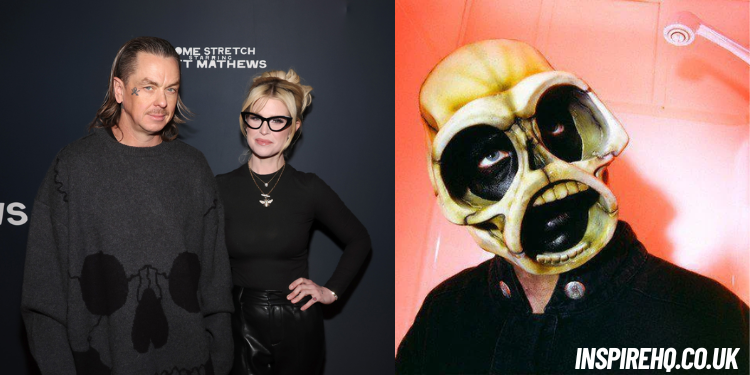Sid Wilson, the DJ and turntablist for the heavy metal band Slipknot, is widely known not only for his aggressive sound but also for his ever-evolving, iconic masks. These masks, which have changed dramatically over the years, are much more than just a stage accessory. They are a form of self-expression, an extension of his personal identity, and a key element of Slipknot’s enigmatic aesthetic. In this article, we will delve deep into the history, evolution, and cultural significance of Sid Wilson mask, exploring their connection to the band’s image, the themes of their music, and the personal expression Sid channels through his choice of masks.
Quick Bio:
| Detail | Information |
|---|---|
| Full Name | Sid Wilson |
| Stage Name | #0 |
| Date of Birth | January 20, 1977 |
| Age | 48 (as of 2025) |
| Height | 5’6″ (168 cm) |
| Occupation | DJ, Turntablist |
| Band | Slipknot |
| Net Worth | $10 million (estimated) |
| Instruments | Turntables, Sampling |
| Role in Slipknot | DJ, Sound Manipulation |
| Social Media | Active on Instagram, Twitter |
| Known For | Unique Mask Designs |
| Birthplace | Des Moines, Iowa, USA |
Sid Wilson: The Man Behind the Masks
Sid Wilson joined Slipknot in 1998 as the band’s DJ, making his contribution crucial to the band’s unique sound. He is known for his energetic performances and the chaotic, yet intricate, turntable work he brings to Slipknot’s music. However, as much as Sid is recognized for his musical talent, it is his ever-changing masks that have become one of his most defining characteristics.
Slipknot’s emphasis on anonymity has been central to their identity from the very beginning. Each member of the band wears a mask, allowing them to perform without the burden of their personal identities. This anonymity creates an environment where the focus is entirely on the music, the performance, and the collective energy of the band. For Sid, the mask is also a way to explore different facets of his personality, his interests, and his artistic vision.
The Early Days: The Gas Mask
When Sid Wilson first joined Slipknot, his mask was a simple yet haunting gas mask. The gas mask not only aligned with the band’s desire for anonymity but also added to the dystopian, apocalyptic aesthetic that Slipknot embraced. The choice of the gas mask was particularly significant as it symbolized themes of protection, survival, and a sense of danger—all core elements of the Slipknot persona.
Sid’s gas mask was simple in design, with a utilitarian look that emphasized the band’s commitment to creating something raw and primal. The mask’s design was understated but spoke volumes about the tone Slipknot wanted to set with their music. For Sid, this mask helped cement his identity within the group, tying him to the other members whose masks represented various grotesque and disturbing figures.
The Skull Mask: A Darker Evolution
As Slipknot’s music began to take a darker turn with their album Iowa (2001), Sid’s mask also evolved. During this era, Sid’s mask transformed into a more menacing design—resembling a skull. The skull mask was designed with a detailed and eerie appearance that reflected the heavy, chaotic energy of the album. This was a mask that symbolized death, decay, and the darker themes present in Slipknot’s music at the time.
Sid’s skull mask became an iconic part of his image, representing the deeper emotional and thematic content in Iowa. The mask’s ominous nature mirrored the themes of anguish and inner turmoil explored in the album’s songs. At this point, Sid’s mask had become a reflection not only of his artistic style but also of the emotional depth and intensity of Slipknot’s evolving music.
A Robotic Transformation: Embracing Futurism
In 2004, with the release of Vol. 3: (The Subliminal Verses), Sid Wilson introduced a new era of mask designs. For this album cycle, Sid opted for a futuristic, robotic mask that marked a clear departure from his previous skull masks. The mask featured an intricate design that included mechanical elements and an expressive animatronic face. This was a major shift for Sid, who had previously relied on more organic designs.
The robotic mask reflected Sid’s interest in futuristic aesthetics, particularly his love for pop culture references like the Transformers franchise. The mask had mechanical parts that could move, including animatronic eyebrows, adding a layer of interactivity to his stage persona. This mask was not only a representation of his growing interest in technology and the future but also a bold statement about Sid’s willingness to push the boundaries of his visual identity within the band.
The Leather Masks: A Steampunk Influence
In 2013, Sid collaborated with renowned Ukrainian mask designer Bob Basset, resulting in a series of handcrafted leather masks. These masks represented a fusion of gas mask aesthetics with elements of steampunk, creating a unique and detailed look for Sid. The collaboration with Bob Basset was a departure from the more industrial or robotic designs of the past, incorporating an artisanal, handcrafted quality that allowed for deeper personalization and artistic expression.
Sid’s leather masks brought a new level of complexity to his on-stage persona. They were both functional and artistic, embodying themes of survival and technological evolution. The masks were meticulously crafted, with each one being unique, which added an air of exclusivity and depth to Sid’s image. These masks also reflected the increasing focus on artistry and craftsmanship in Slipknot’s overall visual direction.
The Animatronic Face Mask: A Bold New Statement
By 2019, Sid Wilson unveiled his most ambitious mask yet—the animatronic face mask. This mask was introduced during the We Are Not Your Kind era and marked a significant evolution in Slipknot’s visual identity. The mask featured a mechanical, almost lifelike face that resembled Sid’s own, yet partially obscured by a black hood and robe. The animatronic features of the mask allowed it to express different emotions, adding a new dimension to Sid’s performance.
The mask was a stark departure from the more abstract and symbolic designs of previous years, making a bold statement in terms of both technology and visual artistry. The mask also drew comparisons to sinister characters in popular culture, such as Emperor Palpatine from Star Wars, contributing to its eerie and unsettling presence. This mask underscored Sid’s desire to push the limits of what could be achieved in terms of live performance aesthetics and visual storytelling.
The Cultural Impact of Sid Wilson’s Masks
Sid Wilson’s masks have become more than just performance tools—they have become iconic symbols in the world of metal and beyond. The evolution of his masks mirrors the evolution of Slipknot as a band, reflecting their musical and artistic growth. Each mask is not just a new design; it is a statement, a chapter in Sid’s personal and artistic journey, and an integral part of Slipknot’s identity.
The masks also reflect the themes of anonymity, rebellion, and transformation that have been central to Slipknot’s music since the band’s inception. They are a symbol of the band’s refusal to conform to mainstream ideals and their commitment to creating a unique, immersive experience for their fans. Sid’s masks are more than just a form of artistic expression—they are an integral part of the band’s legacy.
Fans’ Connection to Sid Wilson’s Masks
Sid’s masks have resonated deeply with Slipknot’s fanbase. The connection between fans and the band’s visual identity, including Sid’s masks, is rooted in the anonymity that the masks provide. For fans, the masks represent a sense of mystery and rebellion, and they have become symbols of personal expression and individualism.
Moreover, Sid’s masks have sparked a culture of mask collectors and fans who replicate the designs for themselves. Sid’s ever-changing masks inspire fans to embrace their own individuality, and the masks have become an important part of the Slipknot experience.
Conclusion
Sid Wilson’s masks are a testament to his creativity, his commitment to his band, and his ability to continually reinvent himself. From his early gas mask to the animatronic face, each mask reflects a different aspect of Sid’s personality and artistic vision. These masks are not just for show—they are an integral part of the Slipknot experience, helping to shape the band’s identity and influence countless fans worldwide.
Sid’s masks are not just accessories—they are symbols of the ever-evolving nature of both the band and its members. Through his masks, Sid Wilson has created a visual identity that is as iconic and groundbreaking as the music Slipknot produces. As the band continues to push the boundaries of heavy metal, Sid’s masks will undoubtedly remain a key part of their visual and cultural legacy.
FAQs:
1. Why does Sid Wilson wear a mask?
Sid Wilson wears a mask as part of Slipknot’s commitment to anonymity and theatrical performance. His masks are an expression of his personal artistic vision and help distinguish him within the band.
2. What was Sid Wilson’s first mask?
Sid Wilson’s first mask was a gas mask, which he wore when he joined Slipknot in 1998. It represented the band’s dystopian aesthetic and their desire for anonymity.
3. How have Sid Wilson’s masks evolved over the years?
Sid’s masks have evolved from a simple gas mask to more complex designs, including skull masks, robotic elements, leather designs, and even animatronic features, reflecting both his personal growth and the changing themes of Slipknot’s music.
4. What is the significance of Sid Wilson’s animatronic mask?
The animatronic mask, introduced in 2019, was a significant departure from Sid’s previous masks, featuring mechanical facial movements and symbolizing innovation, personal transformation, and the future of Slipknot’s live performances.
5. Are Sid Wilson’s masks a symbol of something deeper?
Yes, Sid’s masks are symbols of anonymity, rebellion, transformation, and the exploration of personal and artistic identity, which resonate deeply with both Sid and Slipknot’s fanbase.
Also Read: Troubleshooting Common Enriching Students Login Issues










